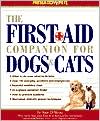First-Aid Companion for Dogs and Cats
Is there an animal doctor in the house?\ Most likely, the answer is no. And when an accident or other emergency threatens your pet, every minute counts. Don't be unprepared! Open The First-Aid Companion for Dogs and Cats and learn:\ * Basic first-aid techniques, such as cleaning a wound, making a splint, and performing CPR— step-by-step!\ * Which over-the-counter human medications can help— or harm— your dog or cat\ * What to keep in your pet's medicine chest (many essential items are...
Search in google:
The First Aid Companion for Dogs & CatsIs there an animal doctor in the house?Most likely, the answer is no. And when an accident or other emergency threatens your pet, every minute counts. Don't be unprepared! Open The First-Aid Companion for Dogs and Cats and learn:* Basic first-aid techniques, such as cleaning a wound, making a splint, and performing CPR— step-by-step!* Which over-the-counter human medications can help— or harm— your dog or cat* What to keep in your pet's medicine chest (many essential items are probably in your house already!)* How to quickly pinpoint what's wrong with your pet, using the First-Aid Symptom FinderPlus, you'll discover a comprehensive A-to-Z guide to more than 150 common— and not-so-common— injuries and conditions, including:* Abscesses (page 60)* Bites from Animals (page 90)* Car Accidents (page 117)* Choking (page 131)* Gunshot Wounds (page 224)* Heatstroke (page 237)* Hot Spots (page 245)* Jellyfish Stings (page 269)* Poisoning (page 311)* Snakebites (page 350)Each at-a-glance entry tells you when to call the vet, which supplies or medications you'll need, what immediate action you should take, and what you should do as follow-up care.By knowing what to do in an emergency and then acting quickly and confidently to take the proper steps, you could save your pet's life. The next time medical help is not quickly available, reach for The First-Aid Companion for Dogs and Cats. It's a pet owner's second best friend.About the AuthorAmy D. Shojai is the author of 12 books about dogs and cats. She lectures around the United States on pet-related topics and is frequently interviewed on national radio and TV. She lives with her husband and pets in Sherman, Texas.
The First Aid Companion for Dogs & Cats\ \ By Amy D. Shojai \ Rodale Press\ Excerpt \ \ \ Basic Techniques and How to Do Them\ \ \ When we think of pet first aid, it's usually limited to emergencies, like being hit by a car or being electrocuted when a puppy chews through a light cord, for example. Luckily, most pet owners will never need to deal with such dramatic problems.\ But all pet owners are faced with everyday problems like ear infections, cut paws, or upset stomachs. Time and again, you'll find first-aid techniques useful. These basic techniques apply to hundreds of dog and cat conditions, whether your pet suffers from a fractured leg, a bleeding wound, or just the sniffles or a splinter.\ What's more, in really dramatic situations, they can save your pet's life.\ \ \ SAFE RESTRAINTS\ \ \ A humane restraint serves three major purposes. First, it protects you from being bitten or clawed by your injured pet while you're administering first aid. Second, restricting your pet's movements keeps him from making the injury worse. Finally, the restraint keeps him in one place so that the wound can be examined and treated. Here are some examples.\ \ \ Muzzles\ \ \ Even the most gentle and loving dog or cat will bite in reflex when he's hurt. Commercial muzzles are available from pet-supply stores and catalogs for all sizes and shapes of dog and cat faces. But when you don't have a commercial muzzle handy, you can make one.\ Cats and short-nosed dogs like pugs are a challenge because there's not enough nose for you to tie shut. One of the best muzzles for these pets is a pillowcase. Fit the cloth bag over your pet's head and gently hold it around the neck. The fabric keeps the teeth engaged, and often, pets stop struggling once they can no longer see what's happening. You can pull the pillowcase down as low over your pet's body as necessary to contain his front paws and claws as well—allow just the affected body part to stick out of the pillowcase for easy access so that you can treat it. Some treatments, like a cool-water soak, can be done right through the pillowcase.\ Dogs with long noses are much easier to muzzle. You can use any long piece of material, from a necktie or length of gauze bandage to a leg from a pair of panty hose, or even an extra leash. Loop the material around your pet's jaw and tie it in a single knot (half hitch) on top of his nose. Then bring both ends of the tie back down under his jaw and tie another single knot. Finally, pull the ends behind the base of his neck and tie them in a bow or knot. The muzzle will hold his jaws closed so he can't bite.\ \ \ Restraint Techniques\ \ \ Each form of restraint works best for a specific type of injury. Choose a technique that leaves the injured area accessible for treatment. In most instances, one person restrains the pet while a second person performs first aid. In all cases, it's best to place small pets on a counter or tabletop so that they are at waist level. Medium-size to large dogs are best treated on the floor, with you kneeling beside them.\ Reclining restraint: Place your pet on his side, with the injured area facing up. With one hand, grasp the ankle of the foreleg that's against the ground while gently pressing your forearm across his shoulders. With the other hand, grasp the ankle of the hind leg that's against the ground while pressing that forearm across his hips. This technique works particularly well with medium-size to large dogs and is also recommended for dog breeds with prominent eyes, like Pekingese. (Holding these types of dogs around the neck produces pressure that may pop out their eyeballs.)\ Stretch restraint: With cats and small dogs, grasp your pet by the loose skin at the back of the neck—the scruff—with one hand. Capture both hind feet with the other hand. Gently stretch out your pet and hold him against a tabletop.\ Hugging restraint: Bring one arm underneath and around your dog's neck in a kind of half-nelson to hug him to your chest. With the other arm, reach under and around his chest and pull him closer against you. This technique works best for dogs over 20 pounds and is most useful when trying to immobilize the abdomen, legs, chest, and back. (For women, a better alternative may be to reach over and around the dog's chest, as shown on page 272.)\ Kneeling restraint: Pressure around the necks of dogs with prominent eyes, like Pekingese, may pop out their eyeballs. So with these breeds, instead of restraining with a neck grip or by the scruff, put your dog on the floor between your knees and facing away from you as you kneel. Then put one hand on top of your dog's head and the other around or beneath his jaws to steady his head while another person treats the area. This form of restraint also works well for giving pills to cats.\ \ \ ARTIFICIAL RESPIRATION AND CPR\ \ \ Your pet's cardiopulmonary system works like a superefficient cargo train that circles the body and never stops. The lungs dump the cargo—oxygen—into the bloodstream, while the heart serves as the engine that moves the blood. By the time blood completes a full circuit around the body and returns to the lungs, the oxygen has been off-loaded where it's needed so that the train can take on a fresh oxygen supply and repeat the process. Anything that interrupts your pet's breathing or heartbeat stops him dead in his tracks. He'll lose consciousness, and failure to receive oxygen for even a few minutes causes irreversible brain damage.\ \ \ Artificial Respiration\ \ \ Pets usually go into respiratory arrest first; the heart may continue to beat for a short while even after a pet's breathing stops. You must begin artificial respiration within minutes to save your pet's life. Start rescue breathing immediately, but be prepared to continue in the car on the way to the hospital. Have somebody else drive while you work on your pet—it's not unusual for a cat or dog to be saved after an owner breathes for them for 1/2 hour or more.\ A pet who is very cold may breathe much more slowly than normal, so be sure that he has stopped breathing. Watch for the rise and fall of his chest or feel for his breath on your palm. If he is not breathing, his gums will turn blue from lack of oxygen.\ Before beginning artificial respiration, check to see if the airway is clear. Open your pet's mouth and look inside for a foreign object. If the airway is blocked, grab his tongue and pull it outward to dislodge the object, or reach in with your fingers or small pliers or tongs to grab it. If you can't reach it, use the Heimlich maneuver (see page 22). Once the airway is open, begin rescue breathing.\ \ \ * Lay a large pet on his side (you can cradle a small pet in your lap) and straighten his neck by lifting the chin so that his throat offers a straight shot into his lungs.\ * Mouth-to-mouth breathing won't work because you can't seal your pet's lips with your mouth, and too much air escapes. Instead, close your pet's mouth with one or both hands to seal it.\ * Put your mouth completely over his nose (with a small pet, your mouth will cover both his nose and mouth) and blow with two quick breaths, watching to see if his lungs expand. Air will go directly through the nose and into the lungs when the mouth is sealed correctly.\ * Blow just hard enough to move his sides. For a very large dog, you'll need to blow pretty hard, but blow gently for cats and tiny dogs, or you could rupture their lungs. Between breaths, let the air naturally escape out of the lungs before giving the next breath. Give 15 to 20 breaths per minute until he begins breathing on his own or you reach the veterinarian.\ \ \ Cardiopulmonary Resuscitation (CPR)\ \ \ CPR combines artificial respiration with external heart compressions, which help move blood through the body when the heart has stopped beating. Follow the instructions for rescue breathing, and alternate with chest compressions. It's best to have two people perform CPR, with one breathing for the pet while the other does chest compressions.\ To tell if your pet's heart has stopped, place your palm flat against his lower chest directly behind the left front elbow to feel for the heartbeat, or place your ear against the spot and listen. You can also feel for the pulse in the femoral artery that's located close to the surface on the inside of the thigh at the groin. Place three fingers flat against this area and press firmly, and you should feel it. Another clue: Pets with stopped hearts won't respond to anything. Pinch your pet firmly between his toes or tap his eyelid. If he doesn't blink or flinch, start CPR immediately.\ \ \ For Cats and Small Dogs (Less Than 20 Pounds)\ \ \ * The "cardiac pump technique" calls for compressions directly over the heart to literally squeeze the heart to pump blood. Do this with all cats and with dogs weighing less than 20 pounds. To find the heart, gently flex your pet's front left foreleg backward. The center of the heart is located just where the point of the elbow crosses the chest.\ * Place your pet on his side on a relatively flat, firm surface. Cup your hand over the point of the chest just behind the elbows. Squeeze firmly, pressing in about 1/2 inch, with your thumb on one side and your fingers on the other.\ * You can also perform compressions between your fingers on kittens and puppies. Cradle your pet in the palm of your hand, with your thumb over the heart and your fingers on the other side. Squeeze rhythmically to make the heart pump.\ * Veterinarians recommend 80 to 100 compressions a minute. That's a little more than one per second, which can be hard to do without training. If you can manage 60 to 100 per minute, you're doing fine.\ \ \ For Medium and Large Dogs (More Than 20 Pounds)\ \ \ * Dogs who weigh more than 20 pounds have such strong bones and so much space between the ribs and heart that compressions won't affect their hearts. Veterinarians recommend that instead of pumping above the heart, you use the "thoracic pump method," which places compressions at the highest part of the chest. That changes the pressure most significantly within the chest cavity, and the increasing and decreasing pressure moves blood forward. Place one hand on top of the other against the chest and push down 25 to 50%.\ * For a barrel-chested dog like a bulldog, lay the dog on his back, cross his paws over his breastbone, and kneel with his abdomen between your legs. Hold his paws and perform chest compressions by pushing downward directly over the breastbone. If your dog moves a lot while you are compressing his chest, put him on his side, then proceed as described above.\ \ \ Alternate between compressions and breaths, giving one breath for every five compressions for any size pet. Continue CPR until your pet revives or you reach the animal hospital.\ \ \ HOW TO CLEAN WOUNDS\ \ \ Anytime the skin is broken, bacteria or other foreign matter—even the fur—can contaminate a wound and potentially cause infection. Bleeding is a natural cleansing mechanism that helps flush out dangerous material. Don't clean wounds that bleed excessively, as this will just make them bleed more. But for wounds that aren't bleeding, nothing beats first-aid cleansing to protect your pet from further harm.\ If long fur is in the way, trim it with blunt scissors or electric clippers to keep it from sticking to the injury. If you're using scissors, first slip your index and second fingers through the fur and hold them against the wound. Cut the fur level with your fingers, leaving a 1-inch border around the wound. (This technique is illustrated on page 114.) If the skin is broken, dab on a water-soluble lubricant like K-Y Jelly; the trimmed fur will stick to the jelly and wash out easily.\ Most of the time, the injury will be sore, and even the most gentle touch can cause pain. The best way to cleanse a wound is to flush it with cool water or sterile saline contact lens solution to float out debris. You can use the spray attachment from the sink, a garden hose, or even a squeeze bottle of saline solution (be sure to use saline solution only; other contact lens solutions can burn).\ Follow the cleansing with a nonstinging antiseptic solution like Betadine Solution to disinfect the wound. Dilute it with distilled water until it's the color of weak tea, then put it in a plant sprayer and spray the area thoroughly. Once the wound has been disinfected, gently dab it dry with gauze pads or a clean, lint-free cloth.\ \ \ Continues...\ \ \ \ Excerpted from The First Aid Companion for Dogs & Cats by Amy D. Shojai Copyright © 2001 by Amy D. Shojai. Excerpted by permission.\ All rights reserved. No part of this excerpt may be reproduced or reprinted without permission in writing from the publisher.\ Excerpts are provided by Dial-A-Book Inc. solely for the personal use of visitors to this web site. \ \








